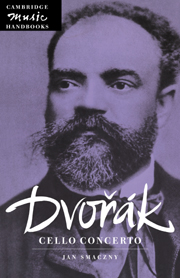Book contents
- Frontmatter
- Contents
- Preface and acknowledgements
- 1 Dvořák and the cello
- 2 Preludes to the Concerto
- 3 The Concerto and Dvořák's ‘American manner’
- 4 ‘Decisions and revisions’: sketch and compositional process
- 5 The score I: forms and melodies
- 6 The score II: interpretations
- 7 Performers and performances
- Notes
- Select bibliography
- Select discography
- Index
6 - The score II: interpretations
Published online by Cambridge University Press: 02 December 2009
- Frontmatter
- Contents
- Preface and acknowledgements
- 1 Dvořák and the cello
- 2 Preludes to the Concerto
- 3 The Concerto and Dvořák's ‘American manner’
- 4 ‘Decisions and revisions’: sketch and compositional process
- 5 The score I: forms and melodies
- 6 The score II: interpretations
- 7 Performers and performances
- Notes
- Select bibliography
- Select discography
- Index
Summary
A concerto for orchestra?
The Cello Concerto was by no means the only concertante project which Dvořák considered during his stay in America. In the summer and autumn of 1893, he seems to have had thoughts about a violin concerto (possibly also a symphony) in G minor and another concerto without instrumental designation. Even more intriguing was another idea which Dvořák toyed with, also in 1893. According to a note in the first American sketchbook the work in question was to be a: ‘Concerto for orchestra, in each movement one of the instruments dominates’. Unfortunately this boldly imaginative project, which anticipates Hindemith, Kodaly and Bartók by several decades, remained unrealised, but the tendency towards an orchestral style in which one instrument dominates had already emerged in the second movement of the ‘New World’ Symphony, with its extended and unforgettable solo for the cor anglais. From many points of view, the Cello Concerto develops a similar impulse. While no specific solo instrument challenges the dominant position of the cello, it is by no means the only soloist to be featured. Apart from the memorable use of the horn in the first movement there are notable solos for other instruments: the solo flute in the A-flat minor section of the first movement's development (see bars 229–39), a gathering of wind instruments led again by a solo flute at the quasi Cadenza in the Adagio, ma non troppo (bars 112–26) and the solo violin in the finale (bars 347–79 and 468–73).
- Type
- Chapter
- Information
- Dvorák: Cello Concerto , pp. 64 - 85Publisher: Cambridge University PressPrint publication year: 1999



